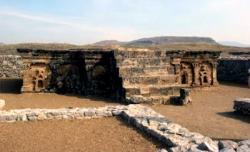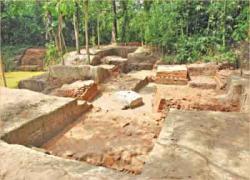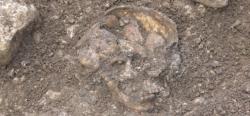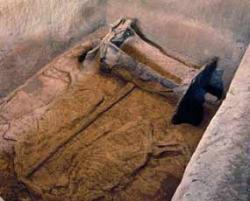INSTITUT SUPERIEUR D'ANTHROPOLOGIE
INSTITUTE OF ANTHROPOLOGY
ONLINE COURSES / COURS A DISTANCE
INSCRIPTION 2012 / Session III : Juillet 2012
REGISTRATION 2012 / Term III : July 2012
PAKISTAN –  Taxila - A team of scholars and students from Taxila Institute of Asian Civilization (TIAC) headed by its Director Prof Dr Mohammad Ashraf Khan has discovered a large number of objects during excavations at ancient Buddhist Stupa and monastery near Taxila. “The most remarkable discovery is an iron nail and animal bones which opened two new chapters in the history of Gandhara. One is that these people knew the use of different metals and the second rejected the notion that the followers of Buddhism at that time were only vegetarian,” said Dr Khan while talking to this correspondent here on Sunday. He said the discovery of animal bones at a deep surface and at the kitchen area was a proof that the monks and followers of Buddhism at that time were not vegetarians. “This will need rewriting of the history of Taxila in the light of the new and substantial evidence.” Dr Khan said the discovery of the iron nail revealed the craftsmanship of the people living in the area between the first century and 4th century AD and their knowledge and utilisation of different metals. He said the other discoveries, including a lamp, terracotta and beads and kitchen pots, belonged to the Kushan period. During the excavations, as many as 55 monk cells were also discovered, he said, adding in the previous excavations such a huge quantity of cells was never discovered in Taxila valley. He said the monastery where the discoveries were made comprised 280 metres area and so far only 80 metres area has been excavated while the remaining was still being unexcavated. Dr Khan said the main water tank area would also be excavated during the current season while during the next session the stupa would be excavated and preserved.
Taxila - A team of scholars and students from Taxila Institute of Asian Civilization (TIAC) headed by its Director Prof Dr Mohammad Ashraf Khan has discovered a large number of objects during excavations at ancient Buddhist Stupa and monastery near Taxila. “The most remarkable discovery is an iron nail and animal bones which opened two new chapters in the history of Gandhara. One is that these people knew the use of different metals and the second rejected the notion that the followers of Buddhism at that time were only vegetarian,” said Dr Khan while talking to this correspondent here on Sunday. He said the discovery of animal bones at a deep surface and at the kitchen area was a proof that the monks and followers of Buddhism at that time were not vegetarians. “This will need rewriting of the history of Taxila in the light of the new and substantial evidence.” Dr Khan said the discovery of the iron nail revealed the craftsmanship of the people living in the area between the first century and 4th century AD and their knowledge and utilisation of different metals. He said the other discoveries, including a lamp, terracotta and beads and kitchen pots, belonged to the Kushan period. During the excavations, as many as 55 monk cells were also discovered, he said, adding in the previous excavations such a huge quantity of cells was never discovered in Taxila valley. He said the monastery where the discoveries were made comprised 280 metres area and so far only 80 metres area has been excavated while the remaining was still being unexcavated. Dr Khan said the main water tank area would also be excavated during the current season while during the next session the stupa would be excavated and preserved.
http://dawn.com/2012/04/09/more-antiquities-discovered-in-taxila-2/
BANGLADESH –  Raghurampur - Archaeological researchers yesterday announced unearthing a wall thought to be of a “Buddhist Vihara” (a monastery constructed during Buddhist rule from approximately the 8th to 11th century) in Raghurampur area in sadar upazila of Munshiganj. “We found a wall, 2.5 meters in width and around 3 feet below the surface. We think it is part of a Buddhist Vihara here,” said Prof Dr Sufi Mustafizur Rahman of archeology department of Jahangirnagar University. So far 30 metres of the wall has been unearthed. “We found three protruding portions from the wall, suggesting the presence of three rooms,” he said. The site is next to the birthplace of Atisa Dipankara Shrijnana (980-1054), a renowned Buddhist monk and scholar, in the adjoining village of Vazrajogini. “This means that the discovery will introduce a new dimension to the dignity and historical importance of the birthplace of Atisa and be a significant achievement for the nation,” he said. The excavations were carried out in two phases, from April to June last year and from January 7, 2012 to yesterday. A total 15 artifacts were presented yesterday, including an around 10-foot by 3-foot wooden boat (thought to be the oldest one unearthed in the country), a 10-inch black stone statute of a woman, a terracotta candle stand and some stone pieces bearing architectural features.
Raghurampur - Archaeological researchers yesterday announced unearthing a wall thought to be of a “Buddhist Vihara” (a monastery constructed during Buddhist rule from approximately the 8th to 11th century) in Raghurampur area in sadar upazila of Munshiganj. “We found a wall, 2.5 meters in width and around 3 feet below the surface. We think it is part of a Buddhist Vihara here,” said Prof Dr Sufi Mustafizur Rahman of archeology department of Jahangirnagar University. So far 30 metres of the wall has been unearthed. “We found three protruding portions from the wall, suggesting the presence of three rooms,” he said. The site is next to the birthplace of Atisa Dipankara Shrijnana (980-1054), a renowned Buddhist monk and scholar, in the adjoining village of Vazrajogini. “This means that the discovery will introduce a new dimension to the dignity and historical importance of the birthplace of Atisa and be a significant achievement for the nation,” he said. The excavations were carried out in two phases, from April to June last year and from January 7, 2012 to yesterday. A total 15 artifacts were presented yesterday, including an around 10-foot by 3-foot wooden boat (thought to be the oldest one unearthed in the country), a 10-inch black stone statute of a woman, a terracotta candle stand and some stone pieces bearing architectural features.
http://www.thedailystar.net/newDesign/news-details.php?nid=230249
SUISSE –  Courroux - Des sondages réalisés l'automne passé ont révélé de nombreux vestiges datant de l'époque romaine et du Haut Moyen Age, dont plusieurs tombes. Un important projet immobilier doit voir le jour à cet endroit. Aussi le Gouvernement jurassien demande-t-il aujourd'hui au Parlement un crédit supplémentaire de 300'000 francs et un crédit ordinaire de 100'000 francs pour la réalisation d'une fouille archéologique, Place des Mouleurs. L'intervention d'urgence de l'archéologie cantonale permettra de dégager et documenter les vestiges avant le début des travaux de construction. Elle durera six mois. Les fouilles se dérouleront à l'intérieur d'un périmètre de protection archéologique lié à la présence des vestiges d'une villa gallo-romaine connue de longue date. Dans les trois tranchées de sondages réalisés en automne 2011 par l'archéologie cantonale, 25 structures ont été observées, dont plusieurs tombes datant du Haut Moyen Age, ainsi que des traces d'au moins un bâtiment en bois remontant à l'Epoque romaine. Ces résultats augurent de la présence de plusieurs centaines de structures enfouies.
Courroux - Des sondages réalisés l'automne passé ont révélé de nombreux vestiges datant de l'époque romaine et du Haut Moyen Age, dont plusieurs tombes. Un important projet immobilier doit voir le jour à cet endroit. Aussi le Gouvernement jurassien demande-t-il aujourd'hui au Parlement un crédit supplémentaire de 300'000 francs et un crédit ordinaire de 100'000 francs pour la réalisation d'une fouille archéologique, Place des Mouleurs. L'intervention d'urgence de l'archéologie cantonale permettra de dégager et documenter les vestiges avant le début des travaux de construction. Elle durera six mois. Les fouilles se dérouleront à l'intérieur d'un périmètre de protection archéologique lié à la présence des vestiges d'une villa gallo-romaine connue de longue date. Dans les trois tranchées de sondages réalisés en automne 2011 par l'archéologie cantonale, 25 structures ont été observées, dont plusieurs tombes datant du Haut Moyen Age, ainsi que des traces d'au moins un bâtiment en bois remontant à l'Epoque romaine. Ces résultats augurent de la présence de plusieurs centaines de structures enfouies.
http://www.arcinfo.ch/fr/regions/jura/vestiges-archeologiques-menaces-a-courroux-555-431254
CHINE –  Lingli - Archaeologists on Monday announced the discovery of a group of 1,800-year-old tombs in the southeastern province of Jiangxi, a finding that will allow experts to learn more about China''s traditional funerary culture. It is believed that the seven tombs belong to a family of the Han Dynasty of the east (24-200), as their order, styles and contents are identical, said Wang Shanghai, deputy director of the Provincial Institute of Cultural Relics and Archaeology. The graves were found by local farmers on a hill in Lingli, a village in the city of Sixi, in the district of Shanggao, while they were working the land in early March, Wang said, quoted by local media. During the excavation works, conducted in collaboration with the Museum of Shanggao, the experts have recovered more than 100 pieces of pottery and porcelain, as well as silver and gold rings, among other objects, according to reports.
Lingli - Archaeologists on Monday announced the discovery of a group of 1,800-year-old tombs in the southeastern province of Jiangxi, a finding that will allow experts to learn more about China''s traditional funerary culture. It is believed that the seven tombs belong to a family of the Han Dynasty of the east (24-200), as their order, styles and contents are identical, said Wang Shanghai, deputy director of the Provincial Institute of Cultural Relics and Archaeology. The graves were found by local farmers on a hill in Lingli, a village in the city of Sixi, in the district of Shanggao, while they were working the land in early March, Wang said, quoted by local media. During the excavation works, conducted in collaboration with the Museum of Shanggao, the experts have recovered more than 100 pieces of pottery and porcelain, as well as silver and gold rings, among other objects, according to reports.
http://www.plenglish.com/index.php?option=com_content&task=view&id=497764&Itemid=1
BULGARIE –  Panagyurishte - Bulgaria's prized Thracian Panagyurishte Gold Treasure is on display Monday in its hometown Panagyurishte, in central Bulgaria. This is the first time that the world-famous piece of historic heritage returns to the town near which it was found, 63 years ago. In 2010, the municipal authorities of Panagyurishte and the nearby city of Plovdiv, Bulgaria's second-largest, had engaged in a conflict over who has more rights to display the treasure, which belongs to the National History Museum in Sofia. The Panagyurishte Gold Treasure was found on December 8, 1949, by three brothers – Pavel, Petko and Michail Deikovi, who worked together at the region of Merul tile factory near the town of Panagyurishte, Bulgaria. It consists of a phial, an amphora and seven rhytons with total weight of 6.164 kg of 23-karat gold. All of the objects are richly and skilfully decorated with scenes fromThracian mythology, customs and life. It is dated to the 4th-3rd centuries BC, and is thought to have been used as a royal ceremonial set by the Thracian king Seuthes III.
Panagyurishte - Bulgaria's prized Thracian Panagyurishte Gold Treasure is on display Monday in its hometown Panagyurishte, in central Bulgaria. This is the first time that the world-famous piece of historic heritage returns to the town near which it was found, 63 years ago. In 2010, the municipal authorities of Panagyurishte and the nearby city of Plovdiv, Bulgaria's second-largest, had engaged in a conflict over who has more rights to display the treasure, which belongs to the National History Museum in Sofia. The Panagyurishte Gold Treasure was found on December 8, 1949, by three brothers – Pavel, Petko and Michail Deikovi, who worked together at the region of Merul tile factory near the town of Panagyurishte, Bulgaria. It consists of a phial, an amphora and seven rhytons with total weight of 6.164 kg of 23-karat gold. All of the objects are richly and skilfully decorated with scenes fromThracian mythology, customs and life. It is dated to the 4th-3rd centuries BC, and is thought to have been used as a royal ceremonial set by the Thracian king Seuthes III.
http://www.novinite.com/view_news.php?id=138545
INDE – Kolhapur - It would stretch anyone's imagination to believe that a maze of dilapidated buildings along the banks of the Panchganga river here was once a magnificent palace, the abode of a famous Maharashtrian king. Visitors to this city though, are often asked to believe this fact, even as the sprawling "palace" with six wings seems to crumble right before their eyes. The birthplace of the famous Rajarshi Shahu Maharaj who brought the 'golden period' in Kolhapur from 1884 to 1922 by abolishing several evils like untouchability and child marriage, the Lakshmi Vikas Palace is in an advanced state of ruin, its cultural and historical significance overlooked and neglected. However, this is soon about to change with the state archaeology and tourism departments joining hands to restore it and develop it as a modern tourist facility.
http://news.outlookindia.com/items.aspx?artid=759769
ROYAUME UNI – Boroughbridge - A medieval silver matrix found by a metal detector enthusiast near Boroughbridge is officially “treasure”, a coroner has found. Metal detectorist Neil Cocliff found the 700-year-old piece of silver jewellery in a field near Little Ouseburn , and reported it to archaeology officials. As the find is more than 10 percent silver - a precious metal - it qualifies as “treasure” under the laws governing archaeological finds, and a museum must be given the chance to buy it. The silver seal was described by Finds Liaison Officer Amy Downes as being in “very good condition”. It shows an inscription that translates as “Seal of William Walls”, and features a stylised animal head and fleur-de-lis design. Measuring approximately 37 x 20 x 4.8mm, it weighed 8.78 grams.
http://www.ripongazette.co.uk/news/ripon/medieval-treasure-found-in-field-1-4452667
USA – Ozette - Occupied for over 2,000 years, the site has been called the Pompeii of the West because of the excellent preservation of items and architectural features of six long houses buried under a 1700 landslide.
http://www.elpasoinc.com/calendar/lifestyle/article_a9d62ae8-8748-11e1-b2ee-001a4bcf6878.html